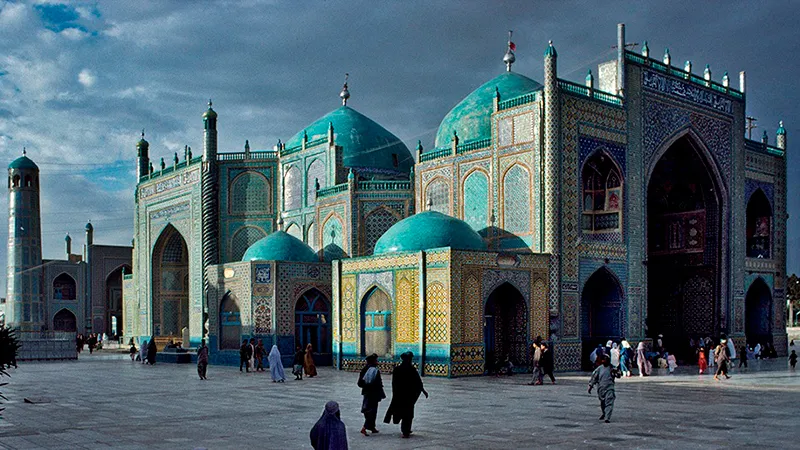Iran wants a stable Afghanistan and it aims to achieve that goal by placing Kabul at the forefront of its foreign policy. But, some experts also argue that there is another point in Iran’s agenda — to spread the influence of Shia Islam across western Afghanistan.
The Khaf-Herat railway line, connecting eastern Iran and western Afghanistan, was supposed to be implemented by March this year. Even though the project has come to a halt due to lack of funds, the idea behind the project is more than just improving the economic ties between the two countries.
The railway project has sixty percent financial backing from Tehran. On one hand, this shows Tehran’s eagerness to facilitate economic support to its neighbouring province. On the other, it also proves the failure of the first aspect of its foreign policy, which is to engage in reconstruction projects in Afghanistan to keep the rise of the Taliban at bay.
The Shindand airbase, which is the second largest in Afghanistan, is also located in Herat. The airfield which was once under Soviet control is located less than seventy-five miles from Iran.
Its remote location enables the US military to carry out surveillance actions against it which is a point of concern for Tehran. This underlines the importance of the second aspect of Iran’s foreign policy, which is to limit any presence of foreign troops in the region. The presence of US troops in Shindand since 2002 has so far prevented Iran from taking an aggressive approach towards this problem.
With both dimensions of Iran’s foreign policy not being fully accomplished, the idea of using religion as a tool to improve its political footing in Afghanistan seems plausible. The Herat province, which shares its border with Iran, is home to the majority of the Shia population of Afghanistan. Due to its cultural and linguistic affinity with the Shi’ite nation, Herat automatically becomes a determinant in formulating Iran’s Afghanistan policy.

Herat's local population does not deny Tehran’s increasing influence. Afghan journalist Ali Asghar Yaghobi, in his interview with The Diplomat in 2013, claimed that the Iran-influenced Shia fundamentalists were responsible for an attack on him. He went on to blame the Iranians for spreading Islamic fundamentalism within the region and promoting anti-West policies.
Another Afghan writer, Taqi Bakhtiari, in the same interview, validated the claims of Yaghobi. He alleged that the Shia mosques in Herat were sponsored and used by Tehran to propagate anti-West rhetoric. He also claimed that Iran is using its ease of access to Herat as a way to spread its own interpretation of Islam. After the shrinking of US troops later this year, Iran’s attempts to influence ideology in the area could pick up speed.
Furthermore, according to a BBC report in January this year, Iranian presence in the Herat market could provide a financial cushion to the region and promote labour. The Shi’ite nation would want to use any opportunity it gets to improve its political footing in Afghanistan. Herat could act as the focal point for this.
But there is also evidence that contradicts the idea that Iran’s goal is the spread of anti-West principles and Shia Islam. Herat’s former governor, Ismail Khan, safely took refuge in Iran during the late 90s after battling the Taliban forces. Tehran’s objective overlapped with that of the Sunni leader, who held office from 2001 to 2004: To oust the foreign troops and the Taliban from Afghanistan to achieve regional stability.
Another example is the Iranian support to the Northern Alliance, the Afghan faction which fought against the Taliban alongside the US. The group, led by Tajiks, who are primarily followers of Sunni Islam, was backed heavily by Iran after the infamous attacks by the Taliban on Mazar-e-Sharif in 1998.
The director of the American Institute of Afghanistan studies in Kabul, Omar Sharifi, has also stated that Iran’s influence is very limited and is at the local level.
Even though these cases of support to Sunni leaders seemingly separate the religious aspect from Iran’s foreign policy, the changing statements of political figures provide a counter. For instance, former Afghan Prime Minister, Gulbuddin Hekmatyar, took refuge in Iran for a period of six years from 1997.
The Sunni leader, who is blacklisted by the US Department of State, made a statement in July 2015 accusing Iran of interfering in the internal affairs of Afghanistan and even calling it another Israel to the Muslim world.
This does not mean that Tehran is trying to challenge the sovereignty of Kabul. An Afghanistan after the decline of the Taliban and withdrawal of foreign troops will be heavily dependent on Iran for regional support. In the recently concluded 13th Summit of the Organisation of Islamic Cooperation, Iranian President Hassan Rouhani focused on providing support to the Afghan government to help it achieve stability. Tehran aims to be Kabul’s strongest regional ally and the use of sectarian politics in achieving that goal cannot be ruled out.
This commentary originally appeared in The Quint.
The author is a Research Intern at Observer Research Foundation, New Delhi.
The views expressed above belong to the author(s). ORF research and analyses now available on Telegram! Click here to access our curated content — blogs, longforms and interviews.





 PREV
PREV

